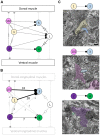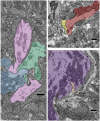Verifying, Challenging, and Discovering New Synapses Among Fully EM-Reconstructed Neurons in the Leech Ganglion
- PMID: 30487738
- PMCID: PMC6246621
- DOI: 10.3389/fnana.2018.00095
Verifying, Challenging, and Discovering New Synapses Among Fully EM-Reconstructed Neurons in the Leech Ganglion
Abstract
Neural circuits underpin the production of animal behavior, largely based upon the precise pattern of synaptic connectivity among the neurons involved. For large numbers of neurons, determining such "connectomes" by direct physiological means is difficult, as physiological accessibility is ultimately required to verify and characterize the function of synapses. We collected a volume of images spanning an entire ganglion of the juvenile leech nervous system via serial blockface electron microscopy (SBEM). We validated this approach by reconstructing a well-characterized circuit of motor neurons involved in the swimming behavior of the leech by locating the synapses among them. We confirm that there are multiple synaptic contacts between connected pairs of neurons in the leech, and that these synapses are widely distributed across the region of neuropil in which the neurons' arbors overlap. We verified the anatomical existence of connections that had been described physiologically among longitudinal muscle motor neurons. We also found that some physiological connections were not present anatomically. We then drew upon the SBEM dataset to design additional physiological experiments. We reconstructed an uncharacterized neuron and one of its presynaptic partners identified from the SBEM dataset. We subsequently interrogated this cell pair via intracellular electrophysiology in an adult ganglion and found that the anatomically-discovered synapse was also functional physiologically. Our findings demonstrate the value of combining a connectomics approach with electrophysiology in the leech nervous system.
Keywords: EM reconstruction; invertebrate neurobiology; leech; serial block face scanning electron microscopy; synapse.
Figures




Similar articles
-
Patterns and distribution of presynaptic and postsynaptic elements within serial electron microscopic reconstructions of neuronal arbors from the medicinal leech Hirudo verbana.J Comp Neurol. 2016 Dec 15;524(18):3677-3695. doi: 10.1002/cne.24120. J Comp Neurol. 2016. PMID: 27636374 Free PMC article.
-
Challenges of microtome-based serial block-face scanning electron microscopy in neuroscience.J Microsc. 2015 Aug;259(2):137-142. doi: 10.1111/jmi.12244. Epub 2015 Apr 23. J Microsc. 2015. PMID: 25907464 Free PMC article. Review.
-
The distribution of synapses on a physiologically identified motor neuron in the central nervous system of the leech. An electron microscope study after the injection of the fluorescent dye procion yellow.J Cell Biol. 1972 Oct;55(1):205-20. doi: 10.1083/jcb.55.1.205. J Cell Biol. 1972. PMID: 4569409 Free PMC article.
-
Anatomy and activity patterns in a multifunctional motor neuron and its surrounding circuits.Elife. 2021 Feb 15;10:e61881. doi: 10.7554/eLife.61881. Elife. 2021. PMID: 33587033 Free PMC article.
-
Neural control of heartbeat in the leech and in some other invertebrates.Physiol Rev. 1979 Jan;59(1):101-36. doi: 10.1152/physrev.1979.59.1.101. Physiol Rev. 1979. PMID: 220645 Review.
Cited by
-
Volume electron microscopy.Nat Rev Methods Primers. 2022 Jul 7;2:51. doi: 10.1038/s43586-022-00131-9. Nat Rev Methods Primers. 2022. PMID: 37409324 Free PMC article.
References
Grants and funding
LinkOut - more resources
Full Text Sources

